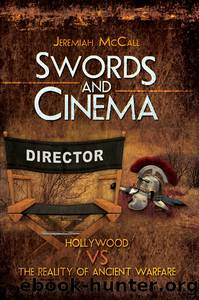Swords and Cinema by Jeremiah McCall

Author:Jeremiah McCall
Language: eng
Format: epub
Tags: PERFORMING ARTS / Film & Video / History & Criticism
ISBN: 9781473875968
Publisher: Pen & Sword Books
Published: 2015-01-14T00:00:00+00:00
Spartacus
Stanley Kubrick and Kurt Douglasâ Spartacus is a Hollywood classic produced in 1959 and based on Howard Fastâs novel. It details the rise and ultimate destruction of thousands of slaves who rebelled against their Roman masters and formed an army that roamed Italy for several years in the late 70s. A Thracian gladiator named Spartacus led the rebel army to victory over several Roman forces. At last, the rebels were decisively defeated by an army under the command of Marcus Licinius Crassus.20 Thousands of survivors from the slave army were crucified along the side of the Appian Way, an object lesson in the dangers of defying Rome.
Unfortunately, Spartacus, in its current form has almost none of the original battle scenes that were shot, save only the final showdown with the army of Crassus. The rest was left on the cutting room floor. There were two concerns at work in the editing process. While concerns about the total length of the film were an issue, there was also a political controversy about how Spartacusâ victories should be interpreted. Filmed at a time when many Americans feared Communist plots, some felt emphasizing Spartacusâ victories would seem too much like endorsing class warfare and revolution.21 Most of the cut footage was subsequently lost. Though the 1991 Restored Criterion Collection version of the film includes some previously deleted footage, little of that has anything of note for our purposes. And so the only significant battle scene occurs toward the end of the film between Spartacusâ and Crassusâ forces.
The scene begins with the camera surveying the rebel army, positioned along a hilltop. The soldiers of Spartacusâ army wear a wide variety of arms and armour, reflecting their need to scavenge for equipment over the past few years. Several of the cut victories over Roman forces are alluded to, however, by the number of fighters who wear Roman armour. All seem to be armed with thrusting spears. The old and young, men and women, are all in arms. After surveying the slave army, the camera shifts to the forces of Crassus across the plain on a hillside marching forward in orderly lines. This is the cohort army of the late Republic in its glory. A shot of Crassus and two officers shows the men in leather muscled-armour with ornate golden decorations. Behind all three are the legionary standards. The camera shifts back to the slave armyâs view and the articulation of the Roman army into cohorts can be seen in the distance. A shift to a position behind Crassus and his officers shows the legionaries marching by.
Ten thousand Spanish soldiers were recruited for this scene.22 The shot is magnificent insofar as in an age before CGI enhancements, it gives a hint of what it must have been like for an enemy of Rome to see such a large and extremely disciplined army. Their approach was captured on cameras about half a mile away that were set on 100ft high cranes.23 What the viewer sees is two
Download
This site does not store any files on its server. We only index and link to content provided by other sites. Please contact the content providers to delete copyright contents if any and email us, we'll remove relevant links or contents immediately.
Call Me by Your Name by André Aciman(20351)
Ready Player One by Cline Ernest(14496)
How to Be a Bawse: A Guide to Conquering Life by Lilly Singh(7364)
Wiseguy by Nicholas Pileggi(5649)
The Kite Runner by Khaled Hosseini(5061)
On Writing A Memoir of the Craft by Stephen King(4847)
Audition by Ryu Murakami(4822)
The Crown by Robert Lacey(4710)
Call me by your name by Andre Aciman(4599)
Gerald's Game by Stephen King(4556)
Harry Potter and the Cursed Child: The Journey by Harry Potter Theatrical Productions(4428)
Dialogue by Robert McKee(4306)
The Perils of Being Moderately Famous by Soha Ali Khan(4156)
Dynamic Alignment Through Imagery by Eric Franklin(4100)
Apollo 8 by Jeffrey Kluger(3621)
Seriously... I'm Kidding by Ellen DeGeneres(3564)
The Inner Game of Tennis by W. Timothy Gallwey(3557)
How to be Champion: My Autobiography by Sarah Millican(3544)
Darker by E L James(3463)
